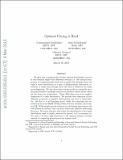Optimal Pricing Is Hard
Author(s)
Deckelbaum, Alan; Tzamos, Christos; Daskalakis, Konstantinos
DownloadDaskalakis_Optimal pricing is hard.pdf (132.6Kb)
OPEN_ACCESS_POLICY
Open Access Policy
Creative Commons Attribution-Noncommercial-Share Alike
Terms of use
Metadata
Show full item recordAbstract
We show that computing the revenue-optimal deterministic auction in unit-demand single-buyer Bayesian settings, i.e. the optimal item-pricing, is computationally hard even in single-item settings where the buyer’s value distribution is a sum of independently distributed attributes, or multi-item settings where the buyer’s values for the items are independent. We also show that it is intractable to optimally price the grand bundle of multiple items for an additive bidder whose values for the items are independent. These difficulties stem from implicit definitions of a value distribution. We provide three instances of how different properties of implicit distributions can lead to intractability: the first is a #P-hardness proof, while the remaining two are reductions from the SQRT-SUM problem of Garey, Graham, and Johnson [14]. While simple pricing schemes can oftentimes approximate the best scheme in revenue, they can have drastically different underlying structure. We argue therefore that either the specification of the input distribution must be highly restricted in format, or it is necessary for the goal to be mere approximation to the optimal scheme’s revenue instead of computing properties of the scheme itself.
Date issued
2012Department
Massachusetts Institute of Technology. Computer Science and Artificial Intelligence Laboratory; Massachusetts Institute of Technology. Department of Electrical Engineering and Computer Science; Massachusetts Institute of Technology. Department of MathematicsJournal
Internet and Network Economics
Publisher
Springer-Verlag
Citation
Daskalakis, Constantinos, Alan Deckelbaum, and Christos Tzamos. “Optimal Pricing Is Hard.” Internet and Network Economics (2012): 298–308.
Version: Author's final manuscript
ISBN
978-3-642-35310-9
978-3-642-35311-6
ISSN
0302-9743
1611-3349